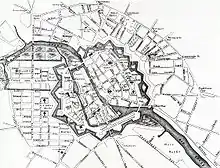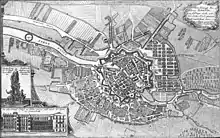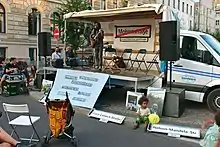Mohrenstraße
Mohrenstraße is a street in central Berlin, Germany. It runs from west to east between Wilhelmstraße and Hausvogteiplatz, and partially forming the southern edge of Gendarmenmarkt. The Berlin U-Bahn station Mohrenstraße is located at its western end, and is served by the ![]() . A number of buildings in the street date to the mid-19th century (Gründerzeit) or were reconstructed after World War II, and are protected historic buildings.
. A number of buildings in the street date to the mid-19th century (Gründerzeit) or were reconstructed after World War II, and are protected historic buildings.
 View of Mohrenstraße, facing east | |
| Length | 900 m (3,000 ft) |
|---|---|
| Location | Berlin-Mitte |
| Construction | |
| Inauguration | May 1707 |
In August 2020, in the context of broader re-examinations of European colonial history spurred by the George Floyd protests, the Berlin borough assembly announced that Mohrenstraße would be renamed Anton-Wilhelm-Amo-Straße, honoring Anton Wilhelm Amo, the first African to receive a doctorate from a German university.[1]
Name
The German word Mohr (pl. Mohren) is an outdated word for persons with dark skin, and is considered by Duden to be discriminatory.[2] It is derived from the Latin Maurus, sharing etymological roots with the word "Moor".
A number of explanations have been proposed for the name.
Named for a black resident
In 1834, Leopold Freiherr von Zedlitz wrote "it has been related that the street was named for a Mohr, who was in the service of the Margrave of Schwedt, and whose lord's generosity allowed him to build a house here."[3]
Named for several black residents
In 1885, Hermann Vogt described the street as "created during the establishment of Friedrichstadt, it received its name from the Mohren that Fredrick William I received from the Dutch and quartered in this street, so they could be posted from here to the individual regiments as Janissaries."[4] Fredrick William I ascended to the throne in 1713 and is documented as having planned the "acquisition of 150 Mohren" in 1714, which dates this theory to no earlier than around 1715.[5] This explanation is an anachronism; the street had already been named in 1707.
Named for colonial-era slaves
During the era of Brandenburg-Prussian colonial rule of the Brandenburger Gold Coast, boys and young men were taken to Berlin and made to work as military musicians, Kammermohren, or valets. In 1680, Frederick William, Elector of Brandenburg tasked his captain Bartelsen with bringing six slaves of ages 14, 15, and 16 years to Berlin.[6] In 1682, he ordered Captain Voss to return with twenty large slaves from 25 to 30 years and twenty boys from 8 to 16 years.[7] Contemporary works also depict the presence of people with dark skin in Berlin, such as Peter Schenk's colorized copper engraving "Schwarzer Militärmusiker am Brandenburger Hof" (1696–1701)[8] and Paul Carl Leygebe's painting of the "Tobacco roundtable of Fredrick I in Prussia", dated to 1709/1710, which depicts three young black men and a servant with a turban in Drap d'Or room of the Berlin Palace.[9]
Named for an African delegation
Historian Ulrich van der Heyden offers the theory that Mohrenstraße was not named with racist or colonial connotations; instead, he proposes that it pertains to a delegation of Africans from Brandenburg's colony of Großfriedrichsburg (present-day Ghana). In van der Heyden's telling, a delegation of 26 Africans, led by Chief Janke, visited Berlin from the village of Pokesu (present-day Princes Town, Ghana) and stayed at an inn outside of Berlin's city walls. The delegation was paying a courtesy visit to Frederick William after the signing of treaties establishing the protectorate. The delegates spent four months in Berlin and visited the palace on foot. The path used by the delegation acquired the name "Mohrenweg" (Mohr-Way).[10]

Christian Kopp, an activist for Berlin Postkolonial e. V., suggests that Ulrich van der Heyden fails to provide evidence supporting his theory. Kopp states that Chief Janke visited Berlin accompanied only by his valet, to subordinate himself to Fredrick William. Kopp states that this visit occurred in 1684, over twenty years before the official naming of Mohrenstraße, citing Richard Schück; no documentation attests to Janke's lodgings. The city plan drawn by Johann Bernhardt Schultz in 1688 does not depict a "Mohrenweg" or inn directly outside the city walls.[11]
History
17th and 18th century

The street was creating around the year 1700 during the construction of Friedrichstadt, now a historical neighborhood in central Berlin. The street originally ended at Mauerstraße. Hausvogteiplatz, at the western end of the street, was the center of the German ready-made garment industry prior to the World War II.[12]
At the end of May 1707, Mohrenstraße was officially named, along with the other streets in Friedrichstadt. This is sourced to a history of Friedrichstadt written by Joachim Ernst Berger (1666–1734), who was a Lutheran pastor from 1697–1732 in Friedrichstadt, containing the following note: "In 1707, at the end of the aforementioned month [May], the alley were for the benefit of the people.") The 9th street name listed is "Mohren-Straße".[13]

Other sources support the naming during the reign of Friedrich I (1688–1713), who was also ruler of the West African colony of Groß Friedrichsburg (present day Ghana) and who planned the constructure of Friedrichstadt. Christoph Friedrich Nicolai wrote about the area encompassing Mohrenstraße and Gendarmenmarkt: "The first construction took place in 1688, from what is today Kronenstraße to Jägerstraße, on the grounds of the former princely folwark and gardens [...] In 1706, the streets received their names."[14] The Berlin city plan of 1710, which was a later reconstruction, mentions the street by name.
The street was later extended to connect to Zietenplatz and the adjacent Wilhelmplatz.
19th century
From 1837-1838, Karl Marx lived at Mohrenstraße 17 during his studies. The house was fitted with a memorial plaque in September 1929, by request of the SPD, which was removed in July 1933 after the Nazis came to power.[15]
21st century

In August 2020, the Berlin borough assembly announced that Mohrenstraße would be renamed Anton-Wilhelm-Amo-Straße, honoring Anton Wilhelm Amo, the first African to receive a doctorate from a German university.[1]
Further reading
- Ulrich van der Heyden: Auf Afrikas Spuren in Berlin. Die Mohrenstraße und andere koloniale Erblasten. Tenea Verlag, Berlin 2008. 9783865041388.
- Ulrich van der Heyden: Die Mohrenstraße, in: U. van der Heyden, J. Zeller (Hrsg.): Kolonialmetropole Berlin. Eine Spurensuche, Berlin 2002, S. 188 f. 9783814800929.
External links
References
- "Mohrenstraße wird in Anton-Wilhelm-Amo-Straße umbenannt". Rundfunk Berlin-Brandenburg (in German). 21 August 2020. Retrieved 21 August 2020.
- "Mohr". Duden (in German). Retrieved 21 August 2020.
- "Neustes Conversations-Handbuch für Berlin und Potsdam zum täglichen Gebrauch der Einheimischen und Fremden aller Stände, enthaltend: die Beschreibung oder Nachweisung alles Wissenswerthen der Oertlichkeit, mit besonderer Berücksichtigung der Beziehungen der Hauptstadt zu den Provinzen" (in German). Berlin: A. W. Eisersdorff. 1834. p. 492.
Den Namen erhielt sie, wie man erzählt, von einem Mohren, welcher sich in den Diensten des Markgrafen von Schwedt befand, und durch die Freigebigkeit des Gebieters hier ein Haus bauen konnte.
- Vogt, Hermann (1885). "Die Straßen-Namen Berlins". Schriften des Vereins für die Geschichte Berlins (in German). Berlin. p. 63.
- Schück, Richard, ed. (1889). Dok. 186: Ramler's Bericht über Anschaffung von 150 Mohren. Vom 25. November 1714 [Doc. 186: Ramler's report about the acquisition of 150 Mohren. From 25 November 1714.] (PDF). Brandenburg-Preußens Kolonialpolitik unter dem Großen Kurfürsten und seinen Nachfolgern (1647–1721) (in German). 2. Leipzig: Verlag von Fr. Wilh. Grunow. pp. 564–566. Archived from the original (PDF) on 23 January 2015.
- Schück, Richard, ed. (1889). Dok. 46: Instruktion für den Kapitän Joris Bartelsen nach Angola und Guinea, 7. Juli 1680 [Document 46: Instruction for Captain Joris Bartelsen to Angola and Guinea, 7 July 1680] (PDF). Brandenburg-Preußens Kolonialpolitik unter dem Großen Kurfürsten und seinen Nachfolgern (1647–1721) (in German). II. Leipzig: Verlag von Fr. Wilh. Grunow. Archived from the original (PDF) on 24 September 2016.
- Schück, Richard, ed. (1889). Dok. 64: Instruktion für den Commandeur de Voss zur Schiffahrt nach der guineischen Küste nebst dem von Gröben, 17. Mai 1682 [Doc. 64: Instruction for Commander de Voss on navigation to the Guinea coast along with that of Gröben, 17 May 1682] (PDF). Brandenburg-Preußens Kolonialpolitik unter dem Großen Kurfürsten und seinen Nachfolgern (1647–1721) (in German). 2. Leipzig: Verlag von Fr. Wilh. Grunow. pp. 129–133. Archived from the original (PDF) on 24 September 2016.
- Schenk, Peter (1696–1701). Kurfürstlich Brandenburgische Militär- und Hoftrachten. Amsterdam.
Figure 20
- Paul Carl Leygebe: Das Tabakskollegium Friedrichs I. in Preußen und seiner dritten Gemahlin Königin Sophie Luise in der Drap dór-Kammer des Berliner Schlosses, 1709/1710
- van der Heyden, Ulrich (2008). Auf Afrikas Spuren in Berlin. Die Mohrenstraße und andere koloniale Erblasten. Berlin. ISBN 9783865041388.
- "White Myths - Black History: Der Fall der Berliner "Mohrenstraße"" [White Myths - Black History: The Case of Berlin's "Mohrenstraße"] (PDF). LaG-Magazin. 25 March 2015. p. 19.
- Manes, Philipp (1941). Die deutsche Pelzindustrie und ihre Verbände 1900–1940, Versuch einer Geschichte (in German). 4. Berlin. (Table of contents)
- Berger, Joachim Ernst (1730). Kernn aller Fridrichs-Städtschen Begebenheiten (in German). Staatsbibliothek Berlin, Handschriftenabteilung. p. Ms Boruss, Quart 124, pg. 30.
A Eodem [1707] im Ausgang besagten Monaths [May], bekahmen die Gaßen, dem publico zum besten, ihre Nahmen.
- Nicolai, Christoph Friedrich (1779). "Beschreibung der Königlichen Residenzstädte Berlin und Potsdam und aller daselbst befindlicher Merkwürdigkeiten" (in German). pp. 152–153.
Die erste Anbauung geschah gleich 1688, von der jetzigen Kronenstraße bis zur Jägerstraße, auf dem Grunde des ehemaligen Churfürstlichen Vorwerks und Gartens [...] 1706 bekamen die Straßen ihre Namen.
- "Karl Marx". gedenktafeln-in-berlin.de (in German). Retrieved 21 August 2020.